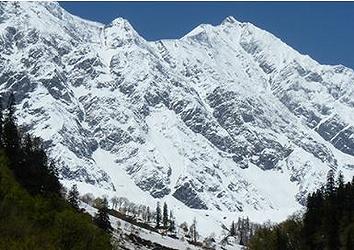
GENEVA, Switzerland, March 14, 2018 (ENS) – The impacts of climate change can be drastic in mountainous regions, where the rise in temperatures is above average, affecting both glacierized landscapes and water resources, finds a team of researchers from the University of Geneva.
These changes are varied, from retreating glaciers to an increase in the frequency and intensity of snow avalanches.
The University of Geneva, UNIGE, scientists employed dendrochronology – the reconstruction of past disasters as recorded in the growth rings of trees – to clarify the role of global warming in the triggering of avalanches.

The results of this study are published in the current issue of the journal “Proceedings of the National Academic of Sciences.”
Avalanches are a natural phenomenon and occur repeatedly in mountain areas; nonetheless, rising temperatures are altering their triggering. This can lead to disasters and serious consequences in mountain areas where they can severely affect the socio-economic development and the destruction of traffic infrastructure, and buildings.
This is the case in the Indian state of Himachal Pradesh, where increasing residential numbers and tourism are exerting pressure on land use.
Along the road to Leh, 500 km (300 miles) north of New Delhi, the Indian government has started to drill one of the largest tunnels of the Indian sub-continent.
With ongoing climate warming, the access road to the tunnel is becoming increasingly threatened by snow avalanches.
For this reason, UNIGE researchers conducted their fieldwork at the spot from 2013 to 2015, in a valley located at between 3,000 and 4,000 meters above sea level.
The researchers have found that trees are silent witnesses to the upsurge in the number of avalanches
The aim of the research group was to evaluate and add to the information currently available about avalanches with two goals: to identify the nature of the changes in avalanche activity currently taking place; and to assess future needs for tackling these changes.
In the absence of data comparable to the information collected in European surveys, for which records often exist for the past few centuries, the UNIGE researchers focused on trees. They examined stumps when the tree had been removed or cored trees that were still standing to reconstruct past snow avalanches at the study site.
The scientists were able to date individual events by analysing the growth rings and wounds left on the trees by avalanches. The research included nearly 150 trees.
“Since we knew the position of each affected tree, we were able to reconstruct the dynamics, lateral extent and runout distance of every avalanche,” explains Juan Antonio Ballesteros-Cánovas, a senior lecturer at UNIGE’s Institute for Environmental Sciences.
“This technique meant we could go back to 1855 and record 38 avalanches over this period in the valley, the largest survey conducted to date in the Himalayas,” he said.
The models used for testing the impact of climate change combine the risks of avalanche with local climate data. They were adjusted to include the likely effect on topographical features resulting from earlier avalanches.
Since avalanches destroy the plant cover, they are an aggravating risk factor.
The results were clear. From the second half of the 20th century, there has been an increase in the number of avalanches, both in terms of frequency and intensity. The frequency has risen from one event per decade to almost one event every year.
The researchers found that today’s avalanches are bigger, travel greater distances and are triggered earlier in the year than avalanches long ago.
These changes can be attributed to rising temperatures, which have reached 0.2 to 0.4 degrees annually in some parts of the Himalayas.
Rising air temperature are also affecting the cryosphere: glaciers are receding and permafrost is melting, losing its role as a sediment stabilizer.
In addition, the structure of the snowpack is changing. It is being transformed by increasingly warmer air temperatures and/or altered by rain-on-snow events.
Snow is now also falling earlier in the season, and is being destabilized before spring, at a time when it is thicker, leading to an increase in the number and intensity of avalanches. Since the snow is wet, avalanches are descending slowly but over a greater distances than in the past.
The research was being carried out within the framework of the Indian Himalayas Climate Adaptation Program, a partnership led jointly by the Indian and Swiss authorities with strong scientific input from UNIGE.
Copyright Environment News Service (ENS) 2018. All rights reserved.
© 2018, Environment News Service. All rights reserved. Content may be quoted only with proper attribution and a direct link to the original article. Full reproduction is prohibited.
